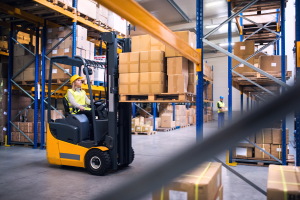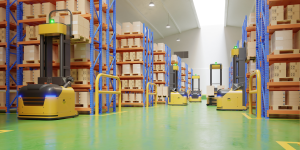Material handling equipment manufacturers are managing multiple wide-reaching trends. The expansion of lithium-ion and other advanced battery technologies has pushed forward more electrified models. And while it is a long-term view, parts of the industry – particularly within distribution centers – continue to envision an autonomous workplace.
However, the trend which may help create the backbone of that self-driving experience is the continued expansion of telematics and machine data – which are helping provide operators, owners, and OEMs a better picture of their material handling assets.
Particularly with rental firms, the primary use of telematics remains the GPS location tracking of equipment, allowing them to fulfill their fleet management needs and continually monitor their equipment.
The next phase of that operational evolution is to use that location data – along with potential beacon technology – for alert operators when they are leaving or entering a designated zone – whether due to a change in terrain, a height or weight restriction, or due to heavy pedestrian activity.
As more and more material handling equipment is electrified, these systems can also report on battery health and charge levels on a regular basis. This type of information can be used to help better understand equipment usage. Data from the telematics device and vehicle bus can also be used to help manage equipment usage and potential maintenance needs. The most obvious of these types of programs is tracking hours of usage to ensure vehicles receive timely oil and fluid changes and other required steps.
All of these systems are also shifting in terms of how they are deployed within the equipment. While many telematics modules are being adapted from on-road to off-road use, the next generation of material handling equipment is looking to tie that machine data into the equipment’s ECU, rather than a standalone separate module.
While ensuring equipment is properly maintained is a core process for most companies, for rental companies the functionality of that telematic link helps ensure lessees are performing the steps required under their rental contract – helping both to avoid disputes down the line and ensure equipment remains in good working order.
The fact that equipment can be remotely monitored can also be very valuable in terms of acute maintenance issues and troubleshooting. Even when they are at a different job site location, trained staff can review reported issues and potentially help resolve them without visiting in-person. This capability has become even more critical in recent years – where trained service personnel are in high demand and teams are challenging to fully staff.
The other core use care for material handling vehicle telematics – which may create even greater benefits – is the ability to manage operator access and influence their behaviors over the long-term.
Access control systems are one of the core ways this type of digital platform can improve overall material handling safety within a facility – ensuring that the equipment will not start unless an authorized – and fully trained – operator unlocks the system with their access badge and completes an OSHA checklist and/or inspection within the system.
 Moving beyond the simple startup authorization, tying all of the machine activity in that session to that operator’s record can start to develop systems in which behavior can be monitored, flagged, and corrected. The system can utilize its pressure and position sensors to understand actions such as driving a loaded lift truck with elevated forks – creating a chance of a tip over – as well as excessive speed, harsh braking, or other actions. These systems can also play a role in battery management and charging behaviors – particularly with lithium-ion models where opportunity charging can help keep equipment available over multiple shifts without battery swaps.
Moving beyond the simple startup authorization, tying all of the machine activity in that session to that operator’s record can start to develop systems in which behavior can be monitored, flagged, and corrected. The system can utilize its pressure and position sensors to understand actions such as driving a loaded lift truck with elevated forks – creating a chance of a tip over – as well as excessive speed, harsh braking, or other actions. These systems can also play a role in battery management and charging behaviors – particularly with lithium-ion models where opportunity charging can help keep equipment available over multiple shifts without battery swaps.
Taken together, all of these benefits can help promote a safer, more effective vehicle fleet either on a job site or within a larger warehouse environment.
Equipment developments in the material handling space continue to shift – ever so slowly in some cases – toward the concept of a fully automated warehouse.
 While there are still several technical hurdles to overcome for that to happen – from object beacons to vision systems to radar/LiDAR capabilities – analysts feel those systems will continue toward a path of wider adoption in the 2030s. That shift will eventually allow OEMs and end users to codify their equipment best practices for the entire warehouse – such as functional safety loops, etc. - into autonomous equipment.
While there are still several technical hurdles to overcome for that to happen – from object beacons to vision systems to radar/LiDAR capabilities – analysts feel those systems will continue toward a path of wider adoption in the 2030s. That shift will eventually allow OEMs and end users to codify their equipment best practices for the entire warehouse – such as functional safety loops, etc. - into autonomous equipment.
But until then, the focus will continue to be on providing as much support to the equipment operators and users to complete their work quickly, efficiently, and safely.
Learn more: www.sensata.com/material-handling